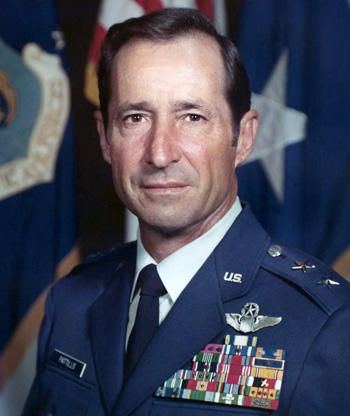
|
Charles C. Pattillo |
 |
|||
| Rank, Service | ||||
Lieutenant General O-9, U.S. Air Force |
||||
| Veteran of: | ||||
|
||||
| Tribute: | ||||
Buck Pattillo was born on June 3, 1924, in Atlanta, Georgia. He enlisted in the U.S. Army Air Forces on November 19, 1942, and entered the Aviation Cadet Program on January 31, 1943. Pattillo was commissioned a 2d Lt and awarded his pilot wings on March 12, 1944, and then completed P-40 Warhawk training before being assigned to the 486th Fighter Squadron of the 352nd Fighter Group in Europe, where he flew P-51 Mustangs from November 1944 to December 1945. During this time he flew 32 combat missions and was credited with destroying 5 enemy aircraft on the ground while strafing enemy airfields. Lt Pattillo left active duty on December 26, 1945, and served in the Air Force Reserve until August 19, 1946, when he joined the Georgia Air National Guard. He was recalled to active duty with the U.S. Air Force on February 27, 1948, and then served with the 31st Fighter Group at Turner AFB, Georgia, from February 1948 to January 1949, followed by flying F-80 Shooting Star and F-84 Thunderjet fighters with the 22nd Fighter Squadron of the 36th Tactical Fighter Wing at Furstenfeldbruck AB, Germany, from January 1949 to July 1952. During this time, Capt Pattillo assisted in organizing the Skyblazers, the U.S. Air Forces in Europe aerial demonstration team, where he flew left wing and alternate lead in over 250 air shows in Europe, Africa, and Asia. He then transferred to the 3600th Combat Crew Training Group at Luke AFB, Arizona, where he helped organize the Thunderbirds, the U.S. Air Force air demonstration team, flying left wing for the squadron's first season. Pattillo then returned to the 3600th Combat Crew Training Group, where he served as a squadron commander and group operations officer from February 1954 to June 1956. His next assignment was as commander of the 391st Fighter-Bomber Squadron at England AFB, Louisiana, from July 1956 to January 1959, deploying with the squadron to Italy from December 1956 to June 1957. Maj Pattillo served as operations officer and then commander of the 613th Tactical Fighter Squadron at England AFB from January to July 1959, and then as a staff officer with the 401st Tactical Fighter Wing, also at England, from July to August 1959. He then received an Air Force Institute of Technology assignment to the University of Colorado, where he received his bachelor's degree in February 1962. From March 1962 to July 1964, Col Pattillo served on the staff of Headquarters Tactical Air Command at Langley AFB, Virginia, and then attended Army War College at Carlisle Barracks, Pennsylvania, from August 1964 to July 1965. He served as director of offense operations with 17th Air Force at Ramstein AB, West Germany, from August 1965 to May 1967, followed by service as commander of the 36th Tactical Fighter Wing at Bitburg AB, West Germany, until May 1968. From May to July 1968, Col Pattillo served as Vice Commander of the 8th Tactical Fighter Wing at Ubon Royal Thai AFB, Thailand, followed by Commander of the Wing until June 1969. During this time, he flew 120 combat missions in the F-4 Phantom II. His next assignment was as Vice Commander of the Oklahoma City Air Material Area at Tinker AFB, Oklahoma, from June 1969 to September 1971, and then as the deputy director for logistics on the Joint Chiefs of Staff at the Pentagon from October 1971 to December 1973. Gen Pattillo was commander of Lowry Technical Training Center at Lowry AFB, Colorado, from December 1973 to August 1975, followed by service as Vice Commander-in-Chief of Pacific Air Forces at Hickam AFB, Hawaii, from September 1975 to February 1979. He was Deputy Commander-in-Chief of U.S. Readiness Command at MacDill AFB, Florida, from March to September 1979, and then Vice Director of the Joint Deployment Agency, also at MacDill, until January 1980. From January 1980 until his retirement from the Air Force on June 1, 1981, he served as both Deputy Commander-in-Chief of U.S. Readiness Command and Vice Director of the Joint Deployment Agency. |
||||
|
||||

